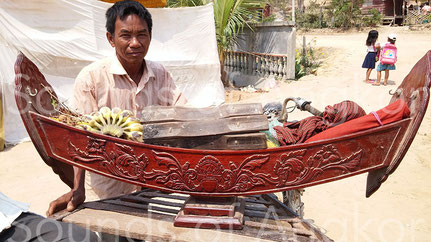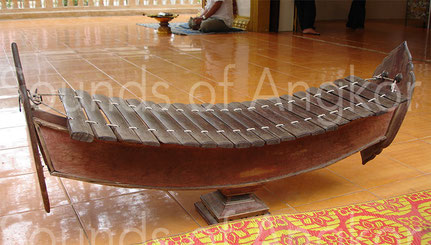Xylophones - roneat ek រនាតឯក / thung ធុង
Last update : December 28, 2024
General

There are two types of xylophones in Khmer music: the roneat ek (also transliterated as roneat aek) and the roneat thung (or roneat thong). The roneat ek is sometimes, though more rarely, referred to as roneat rut.
Each roneat consists of a boat-shaped wooden resonator box, from which are suspended wooden (kranhung, beng, neang nuon) or bamboo (russey) bars. The roneat ek has 21 bars, while the roneat thung has 16. The roneat ek rests on a central stand, whereas the roneat thung is supported by four legs placed at the four corners. The bars are arranged along the curve of the resonator box, and two cords connect them through lateral holes. These openings are located at 2/9 of the total length from the ends, marking the nodes of vibration of the bars. During manufacture, the bars are tuned as follows:
1. By removing material beneath the bars, between the two vibration nodes and at the ends,
2. By applying beeswax mixed with lead shot at each lower end. Musicians themselves perform this operation when adapting their instrument to a new ensemble or retuning it, as the wax dries and
disintegrates, which alters the tuning.
The two wooden pieces (khawals, khaols) at the ends of the resonator box of the roneat ek are triangular in shape, while those of the roneat thung are more semicircular.
The resonator box is either left raw and varnished, or decorated with stenciled floral patterns, carving, or bone inlays (formerly ivory).
In the pin peat orchestra, the roneat ek is always placed to the right of the roneat thung.
Historicity
Many undocumented beliefs and claims circulate in both popular and scholarly literature. Therefore, we will refrain from commenting on this matter. However, based on our own research, we can assert the following: the earliest known depictions of a xylophone in Cambodia are found in two 16th-century frescoes (provisional dating pending scientific verification) in the central sanctuary of Angkor Wat (bakan). These frescoes depict instruments that are still present in the pin peat ensemble today. See our article here. It is, however, likely that bamboo or wooden xylophones, without resonator boxes, existed in the past. Ethnic minorities living at the borders of Cambodia, Vietnam, and Laos still possess such instruments. We are also aware of multilayered lithophones discovered in Viêt Nam, dating from very ancient times (without precise dating for now). It seems difficult to conceive that humans invented such refined and complex instruments without first having experimented with bamboo or wooden versions.
The earliest photographs of roneat were taken by the French photographer Émile Gsell at the Royal Palace of Phnom Penh between 1866 and 1870.
It is worth noting that such xylophones, arranged in pairs, are also played in Myanmar, Thailand, and Laos. Their visual appearance is similarly distinct, with comparable structures, suggesting a common origin.


Range and scalar system
The range of the roneat ek consists of 21 bars, with 7 notes per octave, covering 3 octaves, while the range of the roneat thung is made up of 16 bars, also with 7 notes per octave, spanning 2 octaves and a second. Tuning varies depending on the musician’s generation, the region of Cambodia, and the type of orchestra. Historically, the instrument was equiheptatonic, but it became diatonic under the influence of the French Protectorate, followed by the widespread dissemination of Western diatonic and chromatic music through the media.
Role
These two instruments are used in both pin peat and mahori orchestras. When the pin peat orchestra is complete, it features both xylophones: roneat ek and roneat thung; if not, only the roneat ek is present. According to tradition, the former is considered the female voice and the latter the male voice, which, from a Khmer symbolic perspective, seems inconsistent. Indeed, in a Khmer married couple (if these two roneat are viewed as such), the wife is always positioned to the left of her husband, a tradition already visible in the bas-reliefs from the Bayon period (late 12th to early 13th century). This, if necessary, suggests that the pin peat ensemble is not of Khmer origin! In gong ensembles of ethnic minorities, including some proto-Khmer groups, the largest gong — representing the lowest voice in the ensemble — is always referred to as "mother," while the second, with a higher pitch, is called "father."
Playing
The bars are struck with a pair of mallets, the cylindrical heads of which are covered with cloth or felt. On the roneat ek, the melody is played with the mallets following an octave-based technique. The musician playing the roneat thung, on the other hand, plays in a dissociated manner with both hands. In the orchestra, the roneat ek varies the melody, which is typically carried, depending on the type of ensemble, by a singer or the sralai oboe player. Stylistically, the roneat ek is predominantly played in octaves. To assist beginners, the two mallets are connected by a string, spanning an octave, with all bars being of the same width.
The roneat thung produces a sound one octave lower than the roneat ek.
On December 3, 2017, more than 5,000 monks dressed in orange were invited by the Royal Government of Cambodia for an offering ceremony for peace at Angkor Wat. The pin peat ensemble from the Royal Palace played traditional music while the devotees made offerings to the monks. Notably, the Khmer royal insignia and floral decorations are inlaid on the resonance boxes of the two roneat. The roneat thung is placed, as is customary, to the left of the roneat ek.
The roneat through the iconography of Buddhist monasteries
The pin peat and roneat in particular are a source of inspiration for the decoration of Buddhist monastery buildings. Here we offer some examples.



















